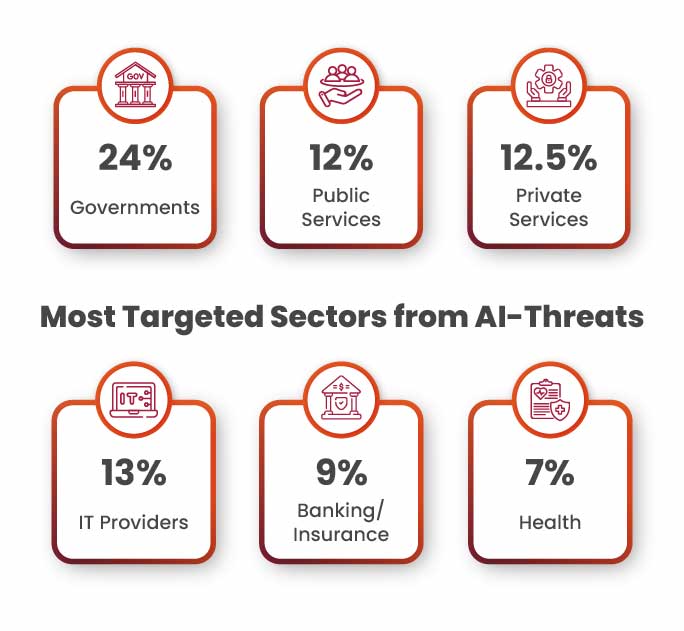Do you know, the digital devices we use are expected to generate an overwhelming 79 zettabytes of data by 2025. With such huge amounts of data, conventional and manual methods of cybersecurity alone are no longer viable. This is because, on one hand, AI empowers organizations with intelligent automation, real-time threat detection, and predictive defense mechanisms. On the other hand, it arms hackers with advanced tools to launch more sophisticated, evasive attacks. This has triggered a full-blown cybersecurity arms race, with 74% of IT security professionals already reporting significant impacts from AI-powered threats, and 75% of cybersecurity teams forced to overhaul their strategies in the past year alone.
In this high-stakes digital battlefield, where the attacks come unnoticed and are powered by AI itself, leveraging AI in Cybersecurity is a no-excuse initiative that needs to be adopted by organisations at the earliest. However, to fight the rogue AI with the ethical AI, knowing the right way is of utmost importance!
Table of Contents
Why Do Organizations Need AI in Cybersecurity?
Cyberthreats are like the dark siblings fighting to overthrow the ethical rulers and take over the empire. We are protecting the same space that the hackers are trying to infiltrate. Organizations are being pushed to the brink, given that 89% of IT security leaders warn that AI-powered cyber threats will become a major concern by 2026. What’s worse? A staggering 77% of organizations admit they’re unprepared to face these emerging dangers. As AI grows smarter, 80% of data experts now agree it’s actually making data security more difficult, not easier, according to Immuta’s 2024 State of Data Security Report. The harsh reality is that without AI-driven defenses, organizations are stepping into a digital battlefield blindfolded, outpaced, outgunned, and utterly exposed.
The infographic below shows the sectors that are most targeted by AI threats. If your organization belongs to any one of these sectors, there is a need to step up your defenses!

How AI in Cybersecurity Fights Growing AI Threats?
However, not all news is bad when it comes to artificial intelligence! AI in Cybersecurity has proven to be an indispensable force in this evolving cyber landscape and its dangers, be it any threats driven by old hacking ways or AI threats, both as a powerful shield and a formidable weapon. Here’s how AI in cybersecurity is strengthening digital defense in an age of increasingly intelligent threats.
Spotting Cyber Threats Before They Strike
One of the many superpower security teams acquired by leveraging AI in cybersecurity is by detecting danger early and even before it causes any damage. If we look at the traditional security methods, they basically rely on known patterns or signatures. However, with AI-driven systems in use, powered by deep machine learning and algorithms, organizations can analyse vast volumes of network data, system logs, and user activity at once. For example, if an employee receives a phishing email with a fake invoice attachment, the AI system can detect suspicious patterns in the file, such as hidden scripts or unusual behavior. It compares the file against threat databases and the user’s normal activity. If flagged as harmful, the AI blocks the download instantly, alerts the user with a warning, and notifies the IT team, thus stopping the threat before it enters the system.
Speeding Up Cyber Response
Speed becomes the difference between a close call and a full-blown crisis in the case of any potential attack. AI needs no rest or breaks, but it is detrimental for human-only security teams. Be it sending instant alerts to security teams or isolating infected systems, AI does it in real-time. Think of it as a digital fire-fighter, either it alerts everyone the very moment or extinguishes itself the moment it sparks. Many organisations use pentest and VMDR tools that can automatically block malicious traffic or isolate affected files without waiting for manual intervention.
Catching More Malware and Phishing Attacks
While we incorporate new tactics and defense strategies, hackers do the same. The recent attacks show that malware delivery and phishing methods have become smarter than ever. But, AI has also turned out to be a huge help for security teams to prevent such attacks. Research shows that the conventional detection methods were able to identify only 30-60% of these threats, but after leveraging AI, the security teams could identify 80-92% of these threats on average, with some achieving 94% accuracy in spotting such attempts using VMDR tools with AI-driven vigilance.
Decoding Mountains of Security Logs
Organizations, given how fast the digital world functions, generate a massive amount of security data every second. The numbers are far more than any security team can analyse effectively, manually. However, given the power of sophisticated cyberattacks, it cannot be neglected. Through AI in cybersecurity, security teams can scan billions of logs to find suspicious patterns. AI adapts in real-time, thus, it helps detect unauthorized access attempts, new attack patterns, insider threats, and other anomalies that manual testing cannot do. Its self-correcting nature allows it to learn from experience, becoming more accurate over time and making it a reliable long-term defense solution.
Guarding Every Device, Everywhere
With the growing norm of remote working and dependence on cloud infrastructure, endpoints like laptops and mobiles are becoming increasingly vulnerable. Incorporating AI in Cybersecurity will allow continuous monitoring of these endpoints. By doing so, it will learn about their typical behaviour and alert security teams if anything seems off. There is a high possibility that AI can help prevent zero-day threats or brand-new attacks that have never been heard of in the near future. Not only that, AI can also help strengthen the login processes further, ensuring only the right people gain access every time.
Predicting and Preventing Future Breaches
AI doesn’t just react, it predicts. Security teams use threat intelligence and predictive analysis to do this. They can leverage AI in cybersecurity to analyze asset inventories, assess access levels, and monitor global cyber trends. Thus, this not only alerts organizations beforehand of possible threats but also empowers organizations to shift from reactive defense to proactive threat hunting. Imagine if security teams get a complete map of vulnerabilities, exposures, and attack patterns, they can mend the holes way before hackers exploit them.
Get in!
Join our weekly newsletter and stay updated
Does Your Contemporary Organizations Worldwide Trust AI in Cybersecurity?
In 2025, organizations worldwide are trusting AI in cybersecurity to fight against modern cyber threats. Research shows that 64% of organizations have started using AI in cybersecurity for threat detection for its unmatched speed and precision qualities. A study last year found that leveraging AI-driven tools has improved incident detection and response significantly. It was found that the time reduced from 168 hours on average to only minutes using these AI-driven tools. As per the survey conducted by The Economist Intelligence Unit, nearly half (48.9%) of global executives and security experts now regard AI and machine learning as critical weapons in the fight against cyberattacks. Moreover, backing this confidence, Pillsbury’s report shows that 44% of organizations worldwide are already harnessing AI to detect intrusions proactively.
Thus, the message is clear: in a world where every second counts, AI is earning its place as a trusted guardian of digital frontlines.
AI vs AI in Cybersecurity: Is AI-Threats a Growing Concern?
AI-generated threats are not just a growing concern; they’re fast becoming an everyday nightmare for cybersecurity teams. In this high-stakes battle of AI vs AI, nearly 97% of cybersecurity professionals fear that their organizations will be hit by AI-driven security incidents. It’s no longer a question of “if” but “when” and “how often”. In fact, 93% of businesses are bracing for daily AI-powered attacks in the coming year, as malicious actors use machine learning to automate, evolve, and outsmart traditional defenses. The danger isn’t going away anytime soon! 87% of IT professionals believe AI-generated threats will haunt their organizations for years to come.
What is the Solution?
Using pentest and VMDR tools like AutoSecT, powered by Kratikal, will help organisations stay secure from these threats that go unnoticed. AutoSecT is an AI-driven cybersecurity solution that cuts through the noise of traditional security systems by eliminating false positives and irrelevant alerts, allowing teams to focus on genuine threats. Leveraging advanced machine learning, AutoSecT continuously monitors cloud environments, anticipates risks before they escalate, and takes proactive steps to prevent attacks by analyzing both historical and real-time data. It provides constant visibility and protection, ensuring minimal risk exposure, faster threat response, and efficient compliance with regulatory standards through automated monitoring and corrective action recommendations.
Book Your Free Cybersecurity Consultation Today!
We’re living in a world where AI is attacking and defending at the same time. But for now, AI in cybersecurity has a key advantage: adaptability using tools like AutoSecT. It learns from every attempted breach, every suspicious login, growing stronger with each new challenge. Hence, as cyber threats become more intelligent and complex, AI is no longer optional; it’s essential. Investing in AI-driven cybersecurity is the best bet against an ever-evolving enemy for organizations aiming to protect sensitive data and maintain customer trust,
FAQs
- How does AI help defend against rising AI threats?
AI in Cybersecurity detects and stops threats in real time by analyzing patterns and anomalies, helping organizations stay ahead of evolving AI-powered attacks.
- Why is AI essential for modern organizations facing AI-powered attacks?
With AI threats growing, AI in Cybersecurity ensures faster detection, automated response, and continuous protection, making it vital for modern digital defense.








Leave a comment
Your email address will not be published. Required fields are marked *